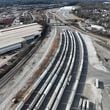Thirty billion hours! That’s the amount of time that we, Americans, spend every year commuting.
It is an insane and irrational collective behavior. We use cars that can reach 130 mph, but we drive them at the same speed as 19th-century horse carriages. Every morning, we are stuck on busy highways, but 85 percent of the cars around us only have one passenger.
If traffic congestion was not such a familiar experience for most of us, this would strike as absurdly tragicomic.
But for me, as a director of healthcare logistics for UPS here in Atlanta, traffic congestion is not a laughing matter. Every day, the iconic brown trucks of my company have to reliably deliver life-critical drugs to more than 100,000 locations across the U.S. Finding efficient solutions and new technologies to manage traffic congestion is an everyday obsession across the board for UPS.
As I was discussing long-term strategies to build congestion-proof transportation networks with a healthcare customer, I made an interesting realization. Our bodies survive thanks to a remarkably efficient transportation network — our vascular system.
Biology has been in the transportation business for billions of years, and there is a lot to learn from it when it comes to imagining the future of urban transportation.
The first learning is that our vascular system is intensively three-dimensional. In fact, biology manages to pack more than 60,000 miles of blood vessels everywhere in each of us.
But if you look at our cities, even as our buildings grew higher, our transportation network is still mostly flat, i.e. two-dimensional with sometimes a heavy reliance on a few major roads. We need to conquer that missing verticality.
The urban transportation of the future will be multilayered with ambitious underground infrastructures, buses that can straddle busy streets, trains that magnetically glide on suspended networks and, yes, more drones and flying vehicles. To regain fluidity, urban traffic needs a third dimension.
The second lesson is that our red blood cells are not dedicated to specific organs or tissues; they are shared. Yet each of our 37 trillion cells gets its own deliveries of oxygen precisely when it needs it. Blood is both a collective and an individual form of transportation.
But for our cities, we have been stuck in an endless debate between developing a car-centric society or extensive mass transit systems.
It is time to transcend this and create new forms of mobility that combine the benefits of both worlds.
What if you could hail a small, self-driving pod that picks you up at your residence, and what if that pod could connect to other pods while circulating on the roads to become a highly utilized and efficient bus? Would that not be an interesting breakthrough?
The third learning is about the circulation flow that needs to change. Our traffic flow is regulated by rigid rules when our blood flow is organic and liquid. Red blood cells do not stop at red lights. They do not flow in lanes. Flow and speed are constantly regulated by our local oxygen needs.
Driverless vehicles will deeply change urban traffic. In a future, driverless Atlanta, vehicles will drive much faster and take any rational initiative that can speed them up and the cars around them.
A driverless traffic flow would look very different from what you know today.
Think of it as a strange traffic mixing the smooth and fast rigor of German Autobahns with the creative vitality of the intersections of Mumbai. Traffic will be functionally exuberant.
And by a strange paradox, the more robotized our traffic grid will be, the more organic and alive its movement will feel.
About the Author





